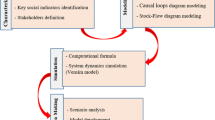Abstract
The research involves connecting hydrology modelling to climate change downscaled output by GIS system to enhance the understanding of the impact of climate change scenarios on the river flow. The study provides the useful hydrology data for the future development in Klang watershed. The Hadley Centre Third Generation—GCM model has been employed for emission scenarios A2 and B2 for the period 2001–2100. The output from statistical downscaling model is used as input into HEC-HMS hydrological modelling to project the discharge of Klang River. Then, the hydrological model output is used to determine the future streamflow in the watershed. To evaluate the future climate change, the long time period of projection to 2100 is divided into three parts (2020s, 2050s and 2080s). The mean annual discharge is predicted to be decreasing by 9.4, 4.9 %, and an increase of 3.4 % for the A2 and a decrease of about 17.3, 14.3 and 6.2 % for the B2 scenario, respectively, in the 2020s, 2050s, and 2080s.



Similar content being viewed by others
References
Bronstert A, Kolokotronis V, Schwandt D, Straub H (2007) Comparison and evaluation of regional climate scenarios for hydrological impact analysis: general scheme and application example. Int J Climatol 27(12):1579–1594
Day CA (2013) Statistically downscaled climate change projections for the Animas River Basin, Colorado, USA. Mt Res Dev 33(1):75–84. doi:10.1659/MRD-JOURNAL-D-12-00067.1
Desa MN, Niemczynowicz J (1996) Spatial variability of rainfall in Kuala Lumpur Malaysia: long and short term characteristics. Hydrol Sci J 41:345–362
Dibike Y, Coulibaly P (2007) Validation of hydrologic models for climate scenario simulation: the case of Saguenay watershed in Quebec. Hydrol Process 21(23):3123–31235
Fiseha BM, Melesse A, Romano M, Volpi E, Fiori EA (2012) Statistical downscaling of precipitation and temperature for the Upper Tiber Basin in Central Italy. Int J Water Sci 1(14). doi: 10.5772/52890
Fu GB, Charles SP, Chiew FHS (2007) A two-parameter climate elasticity of streamflow index to assess climate change effects on annual streamflow. Water Resour Res 43:W11419. doi:10.1029/2007WR005890
Hargreaves GH, Samani ZA (1985) Reference crop evapotranspiration from temperature. Appl Eng Agric 1(2):96–99
Kalnay E, Kanamitsu M, Kistler R, Collins W, Deaven D, Gandin L, Iredell M, Saha S, White G, Woollen J, Zhu Y, Leetmaa A, Reynolds R (1996) The NCEP/NCAR 40-year reanalysis project. Bull Am Meteorol Soc 77(3):437–471
Kavvas ML, Chen ZQ, Ohara N (2006) Study of the impact of climate change on the hydrologic regime and water resources of Peninsular Malaysia. California Hydrologic Research Laboratory 526 Isla Place, Davis, California 95616, USA
Khan MS, Coulibaly P, Dibike Y (2005) Uncertainty analysis of statistical downscaling methods. J Hydrol 319:357–382
Khazaei MR, Zahabiyoun B, Saghafian B (2012) Assessment of climate change impact on floods using weather generator and continuous rainfall–runoff model. Int J Climatol 32(13):1997–2006. doi:10.1002/joc.2416
Malaysian Meteorological Department (2009) Climate change scenarios for Malaysia 2001–2099
Meenu R, Rehan S, Mujumdar PP (2012) Assessment of hydrologic impacts of climate change in Tunga–Bhadra river basin, India with HEC-HMS and SDSM. Hydrol Process 1085–1099. doi:10.1002/hyp.9220
Randin CF, Engler R, Normand S, Zappa M, Zimmermann NE, Pearman PB, Vittoz P, Thuiller W, Guisan A (2009) Climate change and plant distribution: local models predict high elevation persistence. Glob Change Biol 15:1557–1569
Salazar L, Hargreaves GH, Stutler RK, Garcia J (1984) Irrigation scheduling manual. Irrigation Center, Utah State University, Logan
Sayang MD, Jemain AA, Kamarulzaman I (2010) The best probability models for dry and wet spells in Peninsular Malaysia during monsoon seasons. Int J Climatol 30(8):1194–1205
USACE (2000) Engineering and design—flood-runoff analysis In: Army DOT (ed) US Army Corps of Engineers
Wilby RL, Dawson CW (2007) SDSM (4.2)—a decision support tool for the assessment of regional climate impacts, user manual
Wilby RL, Hay LE, Leavesley GH (1999) A comparison of downscaled and raw GCM output: implications for climate change scenarios in the San Juan River Basin Colorado. J Hydrol 225:67–91
Wilby RL, Dawson CW, Barrow EM (2001) SDSM-a decision support tool for the assessment of climate change impacts. Environ Model Softw 17:147–159
Wilby RL, Charles SP, Zorita E, Timbal B, Whetton P, Mearns LO (2004) The guidelines for use of climate scenarios developed from statistical downscaling methods. Supporting material of the Intergovernmental Panel on Climate Change (IPCC), prepared on behalf of Task Group on Data and Scenario Support for Impacts and Climate Analysis
Wurbs RA, Muttiah RS, Felden F (2005) Incorporation of climate change in water avaibility modeling. J Hydrol Eng 10(5):375–385
Yang L, Weiguang W, Chong-Yu X, Zhongbo Y (2012) Statistical downscaling of extreme daily precipitation, evaporation, and temperature and construction of future scenarios. Hydrol Process 26(23):3510–3523. doi:10.1002/hyp.8427
Author information
Authors and Affiliations
Corresponding author
Rights and permissions
About this article
Cite this article
Kabiri, R., Ramani Bai, V. & Chan, A. Assessment of hydrologic impacts of climate change on the runoff trend in Klang Watershed, Malaysia. Environ Earth Sci 73, 27–37 (2015). https://doi.org/10.1007/s12665-014-3392-5
Received:
Accepted:
Published:
Issue Date:
DOI: https://doi.org/10.1007/s12665-014-3392-5




